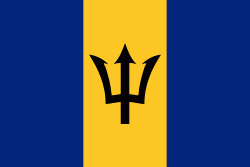Christ Church (Christ Church)
The parish of Christ Church is one of eleven historic political divisions of Barbados. It has a land area of 57 km2 and is found at the southern end of the island. Christ Church has survived by name as one of the original six parishes created in 1629 by Governor Sir William Tufton.
The parish contains the Sir Grantley Adams International Airport as well as the last remaining mangrove swamp in the country, the Graeme Hall Nature Sanctuary. Under Barbados's historic vestry, the main parish church was originally seated near Dover. After it and the courtyard were destroyed by flood in 1669, the main parish church moved to Oistins area, becoming the main town and former capital of the parish. The South Point Lighthouse is located in South Point, Christ Church, between Atlantic Shores and Green Garden, also in Christ Church.
Another notable area of Christ Church is Saint Lawrence Gap, which is the most lively tourist area on the island. Many of the taverns and clubs in St. Lawrence are frequented by locals and tourists alike.
The parish contains the Sir Grantley Adams International Airport as well as the last remaining mangrove swamp in the country, the Graeme Hall Nature Sanctuary. Under Barbados's historic vestry, the main parish church was originally seated near Dover. After it and the courtyard were destroyed by flood in 1669, the main parish church moved to Oistins area, becoming the main town and former capital of the parish. The South Point Lighthouse is located in South Point, Christ Church, between Atlantic Shores and Green Garden, also in Christ Church.
Another notable area of Christ Church is Saint Lawrence Gap, which is the most lively tourist area on the island. Many of the taverns and clubs in St. Lawrence are frequented by locals and tourists alike.
Map - Christ Church (Christ Church)
Map
Country - Barbados
 |
 |
| Flag of Barbados | |
Inhabited by Kalinago people since the 13th century, and prior to that by other Amerindians, Spanish navigators took possession of Barbados in the late 15th century, claiming it for the Crown of Castile. It first appeared on a Spanish map in 1511. The Portuguese Empire claimed the island between 1532 and 1536, but abandoned it in 1620 with their only remnants being an introduction of wild boars for a good supply of meat whenever the island was visited. An English ship, the Olive Blossom, arrived in Barbados on 14 May 1625; its men took possession of the island in the name of King James I. In 1627, the first permanent settlers arrived from England, and Barbados became an English and later British colony. During this period, the colony operated on a plantation economy, relying on the labour of African slaves who worked on the island's plantations. Slavery continued until it was phased out through most of the British Empire by the Slavery Abolition Act 1833.
Currency / Language
| ISO | Currency | Symbol | Significant figures |
|---|---|---|---|
| BBD | Barbados dollar | $ | 2 |
| USD | United States dollar | $ | 2 |
| ISO | Language |
|---|---|
| EN | English language |















